Markets
FCOJ Closed Higher Last Week on Reports of Short Supplies in Florida and Brazil
CitrusBR last week estimated stocks were estimated at 84,745 tons for last season. This was the lowest estimate since 2012 when data collection started and stocks were estimated below 100,000 tons. Production for next year is expected to drop a bit due to weather concerns. FCOJ futures remain supported by very short Oranges production estimates for Florida.

Wheat: Wheat markets closed mostly a little higher with SRW little changed in anticipation of the WASDE reports to be released on Tuesday, Ideas are that USDA will cut demand and increase ending stocks.
Demand has been poor for US Wheat and should remain bad as Russia’s production looks strong and exports from Russia have not abated. It is certain that there will be no grain deal soon for Ukraine’s exports through the Black Sea and any export from the Danube will be difficult if not impossible due to bombing by the Russians.
Ukraine will still be able to ship via land through the EU but this is considered to be a very expensive option for them. It is unlikely that any ship owner or ship insurer will take the chance on any passage of Ukrainian grain through the Black Sea, and maybe not for Russia, either.
The world’s access to Wheat from at least one and perhaps both countries is a lot more restricted. Weather forecasts call for drier weather for the northern Great Plains and Canadian Prairies and some areas will be really hot. Canada is now suffering potential crop losses due to dry weather.
Weekly Chicago Soft Red Winter Wheat Futures
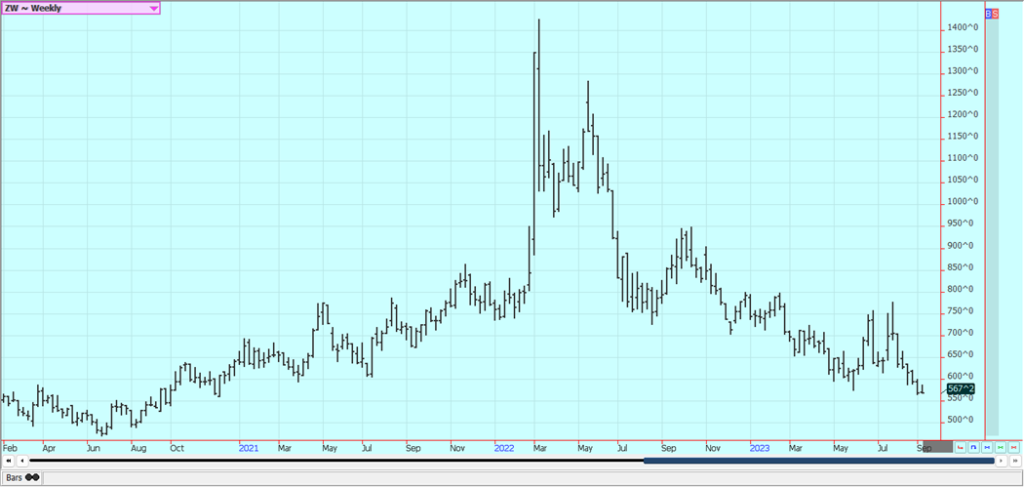
Weekly Chicago Hard Red Winter Wheat Futures
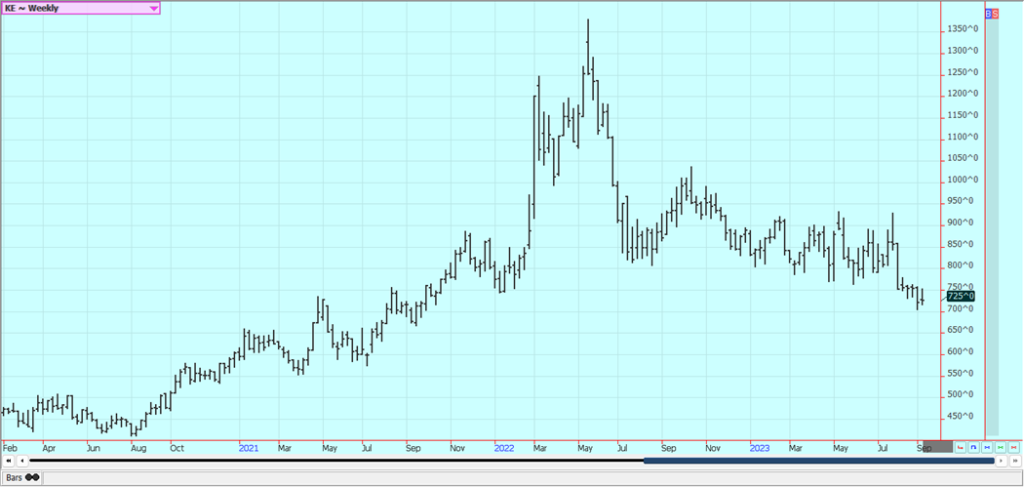
Weekly Minneapolis Hard Red Spring Wheat Futures
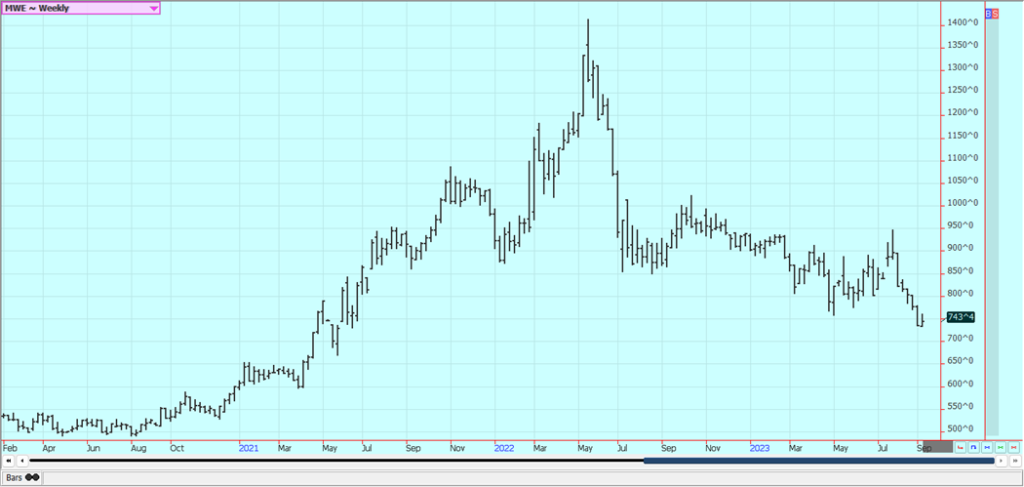
Corn: Corn and Oats were a little higher last week as bad US growing conditions battled increased Brazil Corn production estimates. CONAB raised its production estimate to just over 131 million tons. Expectations are for stressful weather to continue.
Weakness was seen before the WASDE and US production reports to be released on Tuesday on ideas that USDA will show strong production potential once again. Weather forecasts remain mostly dry but with moderate temperatures for the Midwest for the next week.
The crops will need rain to maintain the condition due to the lack of soil moisture from three months of drought that ended at the end of June but the crops are not expected to see much rain if any rain at all. A return to hot and dry weather now could impact yields in a bad way.
Demand for US Corn in the world market has been very low and domestic demand has been weak due to reduced Cattle and other livestock production. The Brazil Corn harvest is underway and so export prices for Corn from Brazil are getting relatively cheap and Brazil is getting the business.
Weekly Corn Futures
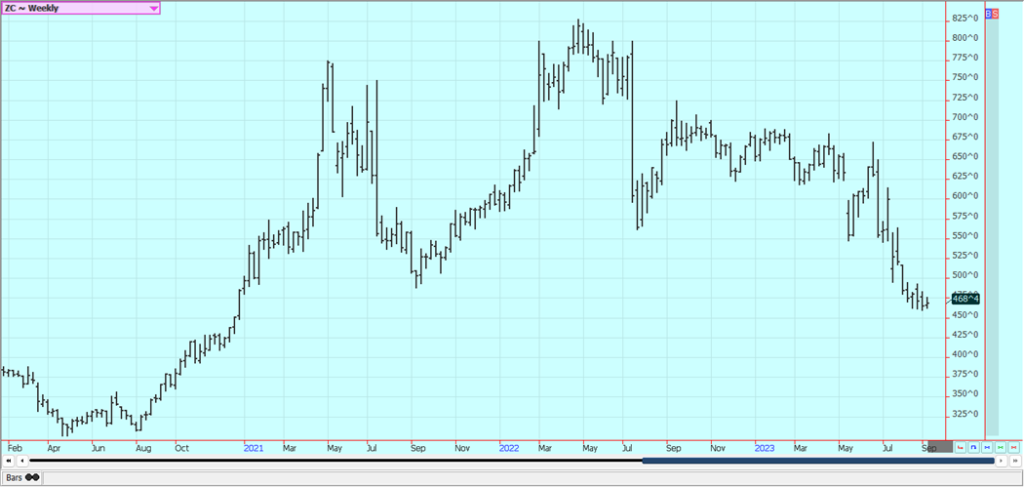
Weekly Oats Futures
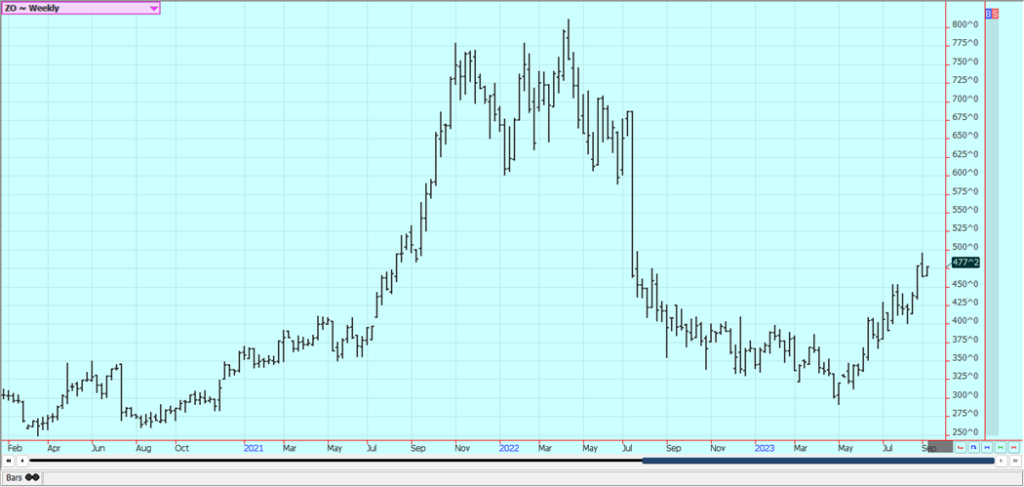
Soybeans and Soybean Meal: Soybeans and the products were lower last week on what appeared to be speculative selling tied to the release of the WASDE and US production reports on Tuesday. Ideas are that the reports will continue to show strong yield potential. Deteriorating crop conditions as reported by USDA on Tuesday could mean lower yield potential in this report and in coming production estimates. USDA cut the good to excellent categories by five percentage points for both Corn and Soybeans.
Highly variable conditions were noted especially in western areas. Weather forecasts call for warm and dry conditions for the Midwest. Most longer-range maps indicate the potential for dry weather. Temperatures are expected to be above normal. Ideas are that the top end of the yield potential is gone and severe damage is becoming possible in some areas.
Brazil’s basis levels are still low, and the US is being shut out of the market for most importers, but the US is price competitive now. Brazil is still selling a lot of Soybeans to China and other countries. Brazil has a very good crop.
Weekly Chicago Soybeans Futures
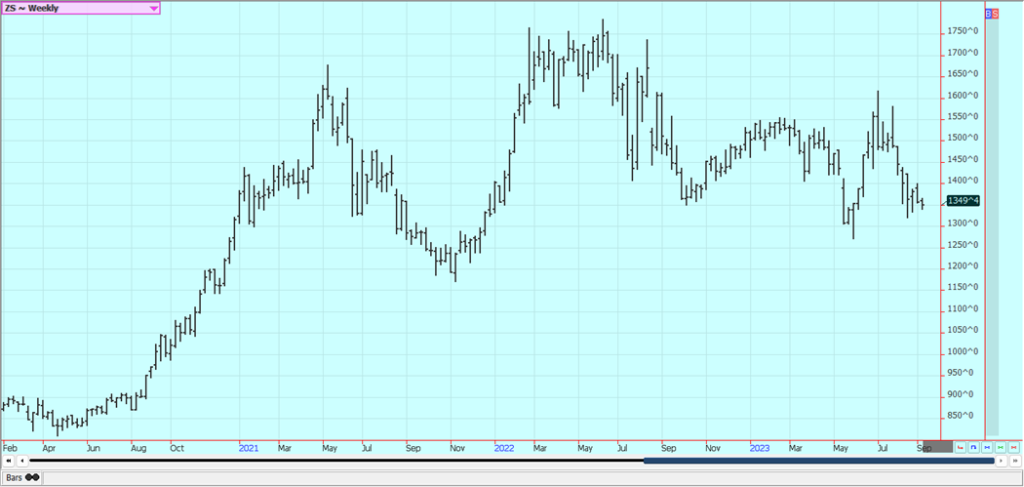
Weekly Chicago Soybean Meal Futures
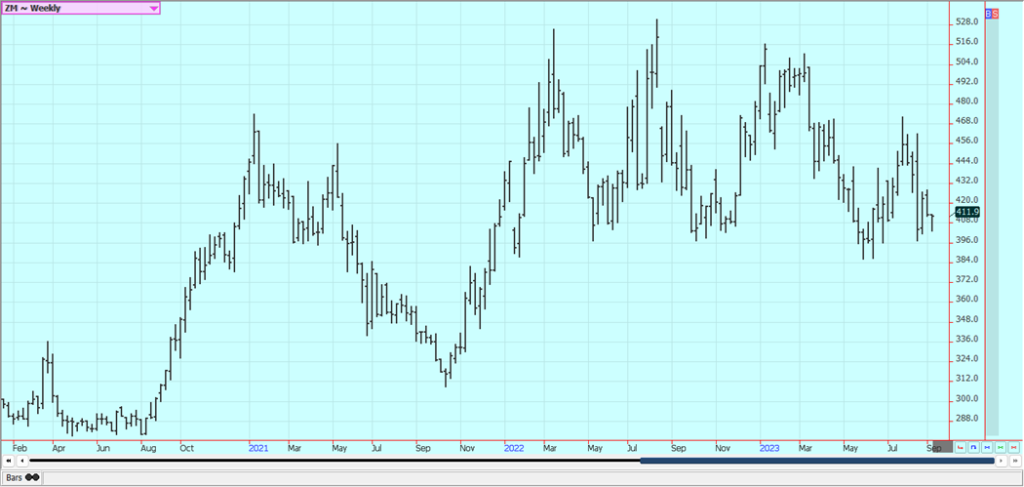
Rice: Rice closed lower last week on what appeared to be speculative long liquidation. Trends are down on the daily charts but up on the weekly charts. Yields are called average to below average in Texas and average so far in Arkansas. The quality has been uneven with some crops affected by the extreme heat in southern areas that has hurt field yields in some areas.
Some fields are getting abandoned due to extreme heat affecting the production in a very negative way. India will not allow Rice exports except for Basmati for now because not enough rain in some production areas. Northern areas are too wet and southern areas are too dry. It instituted a new 20% tax on White Rice exports. India is the largest exporter of Rice in the world, so it was big news and one that implies that a sharp increase in world price is once again possible.
Weekly Chicago Rice Futures
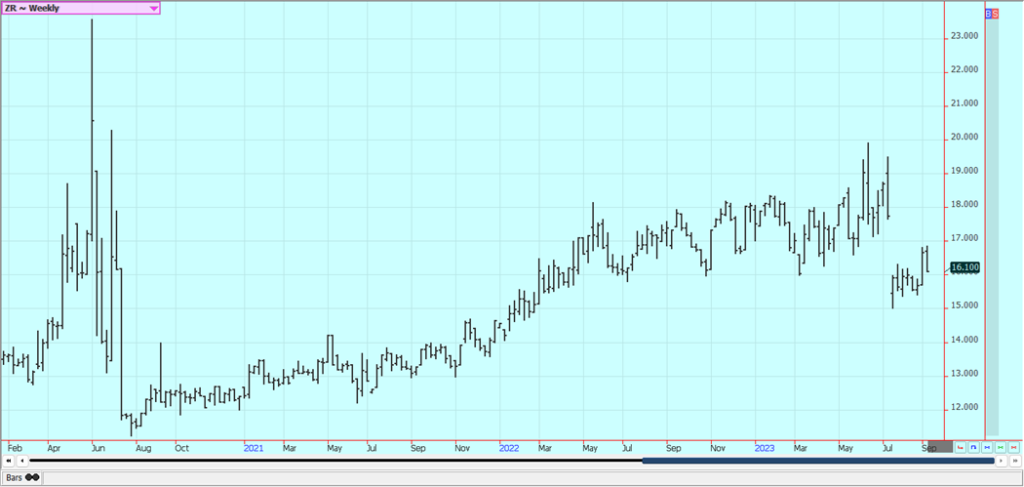
Palm Oil and Vegetable Oils: Palm Oil was lower last week on ideas of weaker demand and strong production. The private sources reported that the export pace is behind that of the previous month.
Production ideas are strong and are helping to keep rallies in check. Canola was lower last week. Drier weather is generally forecast for the Prairies and the crop has been stressed, but some rain is falling now. The StatsCan stocks report showed supplies were above trade expectations.
Weekly Malaysian Palm Oil Futures
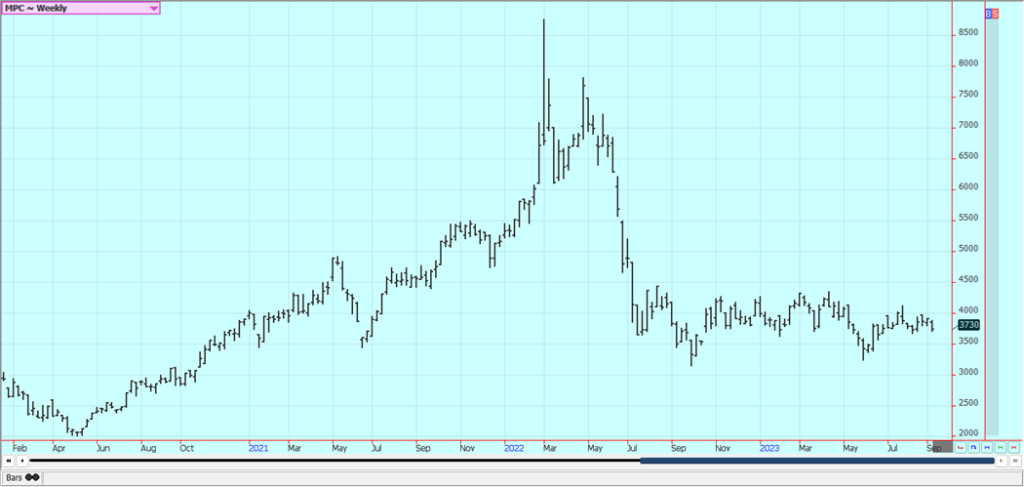
Weekly Chicago Soybean Oil Futures
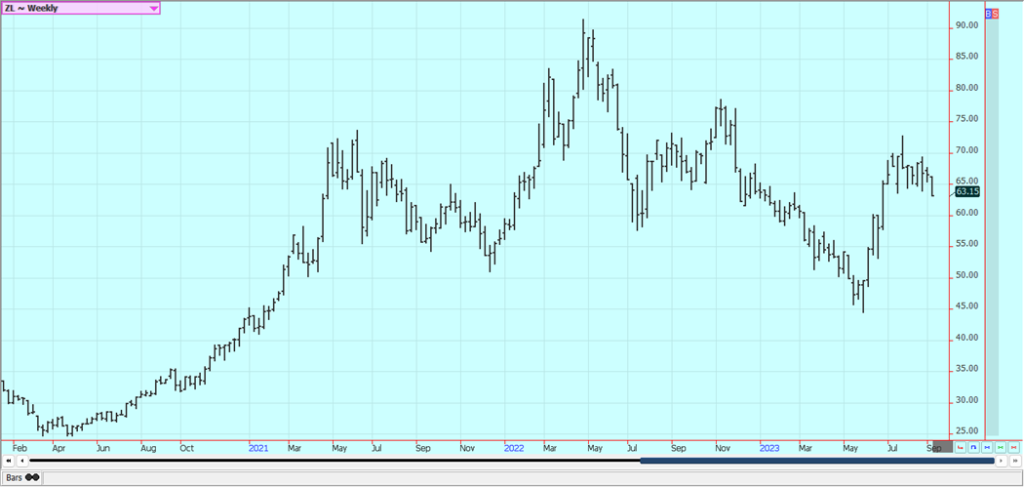
Weekly Canola Futures:
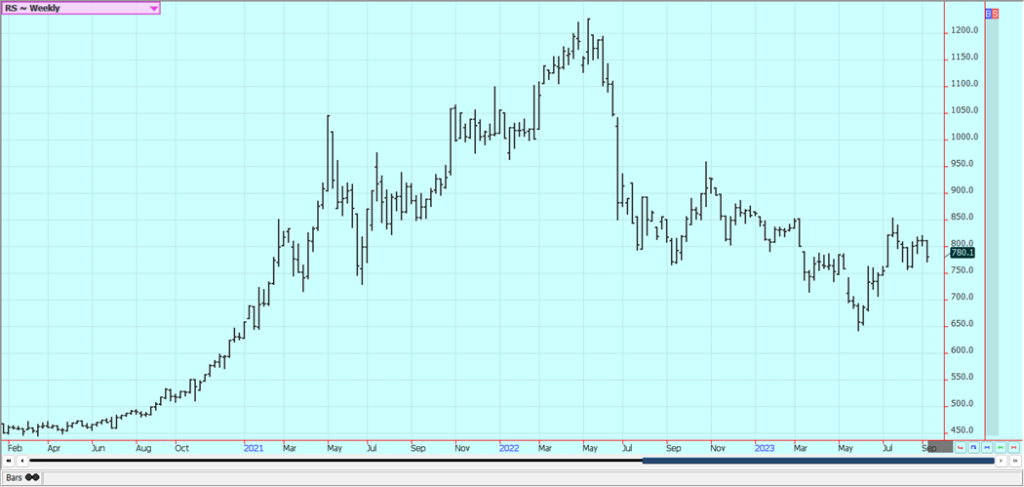
Cotton: Cotton closed lower last week on some long liquidation by speculators but reports of stressful conditions for US Cotton production continue. Weak demand is still a problem. Ideas are around that Chinese economic data implies less US cotton demand for the coming year but demand from other buyers has been good.
There is more talk of a contraction that could develop in China and Cotton demand could be hurt if people have less money to spend on clothes. The heat is still extreme in the southern US and has yet to moderate. Ideas of weaker demand due to economic problems in Asia continue and Chinese economic data continues to show weakness. There are still many concerns about demand from China and the rest of Asia due to the slow economic return of China in the world market.
Weekly US Cotton Futures
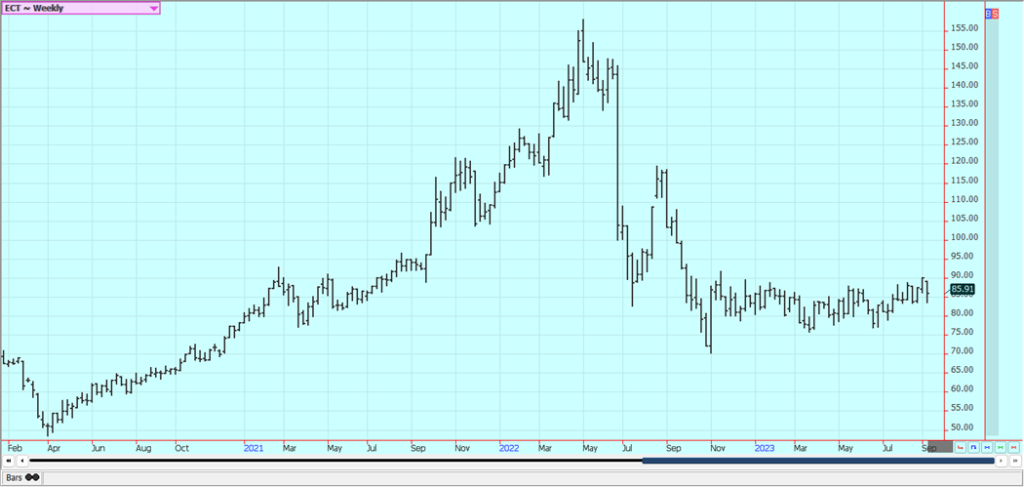
Frozen Concentrated Orange Juice and Citrus: FCOJ closed higher last week on reports of short supplies in Florida and Brazil. CitrusBR last week estimated stocks were estimated at 84,745 tons for last season. This was the lowest estimate since 2012 when data collection started and stocks were estimated below 100,000 tons.
Production for next year is expected to drop a bit due to weather concerns. FCOJ futures remain supported by very short Oranges production estimates for Florida. Futures are also being supported by forecasts for an above-average hurricane season that could bring a storm to damage the trees once again.
Historically low estimates of production due in part to the hurricanes and in part to the greening disease that has hurt production, but conditions are significantly better now with scattered showers and moderate temperatures. The weather remains generally good for products around the world for the next crop including production areas in Florida that have been impacted in a big way by the two storms seen previously in the state
Weekly FCOJ Futures
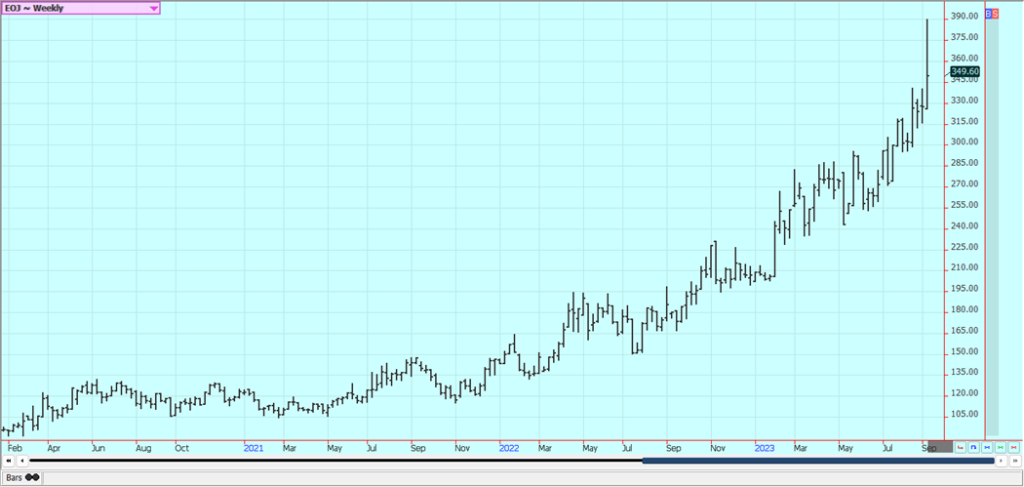
Coffee: New York and London closed lower last week on strength in the US Dollar and ideas of weaker demand from roasters. Offers from Brazil and other countries in Latin America should be increasing but prices are considered a little cheap to create much selling interest from producers.
The Brazil harvest moving quickly and this fact has pressured prices. Vietnam does not offer much Coffee in the world market as domestic cash prices are very high. There are still tight Robusta supplies for the market amid strong demand for Robusta with no offers from Vietnam in the world market due to very high domestic prices.
Weekly New York Arabica Coffee Futures
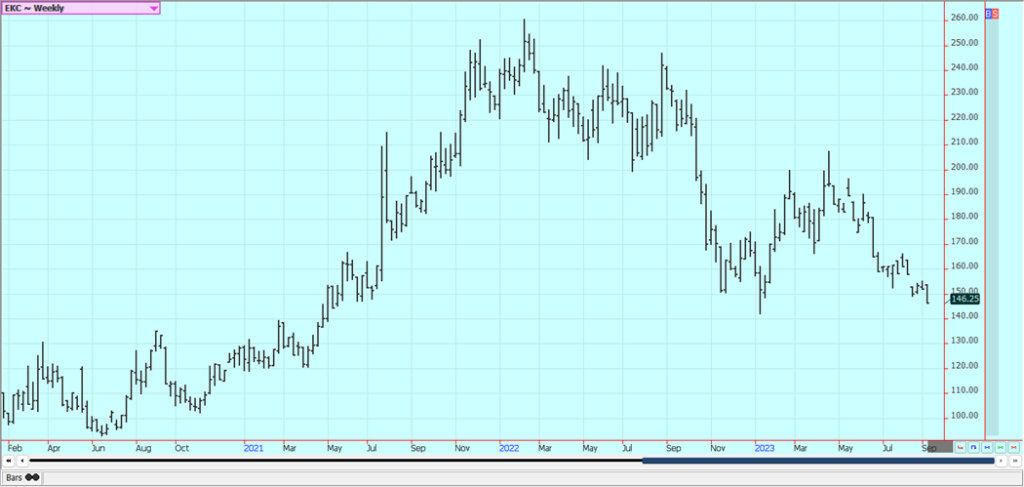
Weekly London Robusta Coffee Futures
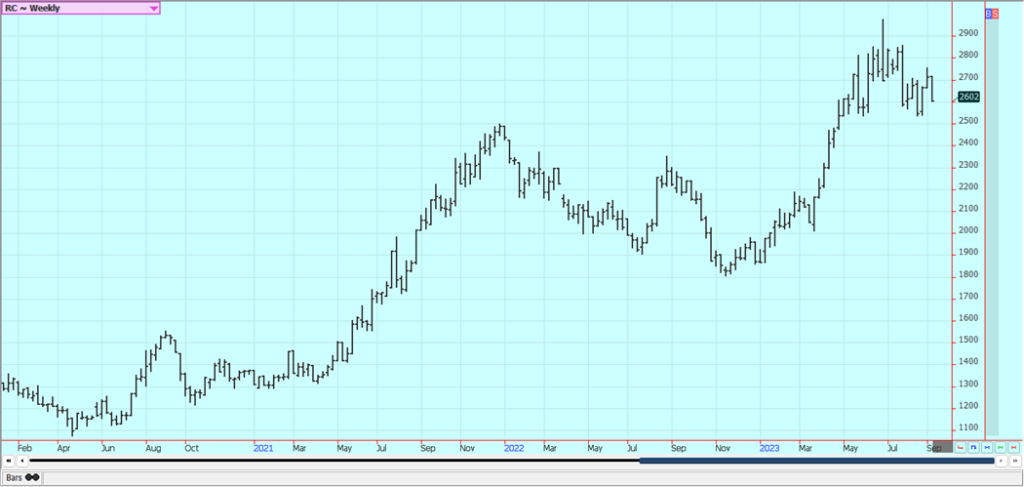
Sugar: Both markets closed lower last week with most of the weakness in New York. The Asian supply situation became more pronounced this week with dry weather the main feature. Traders are more worried about the lack of Sugar exports from India than they are about actual exports from Brazil. The Indian monsoon is expected to withdraw early this year and leave Sugarcane high and dry. Many growing areas have been dry, anyway.
There are also worries about the Thai production potential in this year of El Nino. Reports of increased offers from Brazil are still around but other origins are still not offering, and demand is still strong. Brazil reports very good harvest conditions but the weather in Southeast Asia is currently dry.
Indian production is less this year and Pakistan also has reduced production and the monsoon has been uneven so far in both countries. Thailand production is also down a lot this year and many Asian countries are worried about El Nino impacting future production.
Weekly New York World Raw Sugar Futures
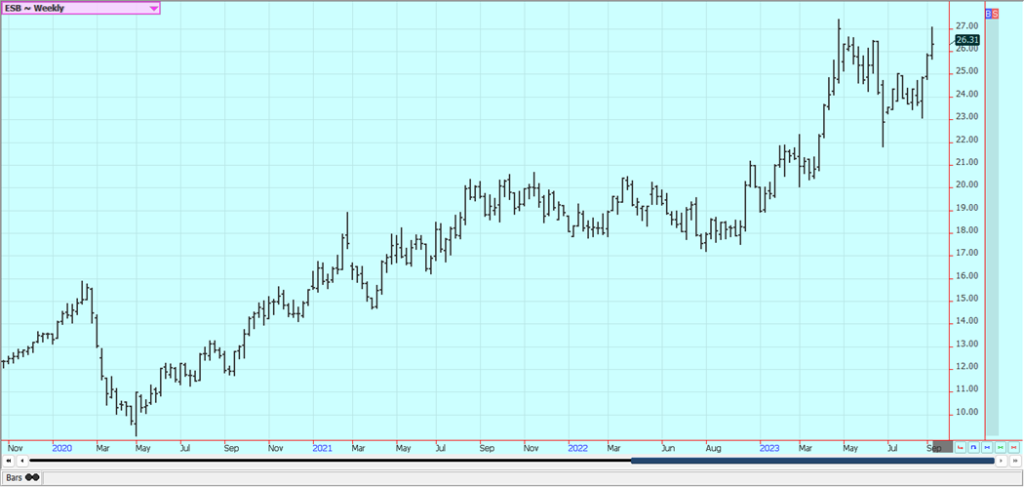
Weekly London White Sugar Futures
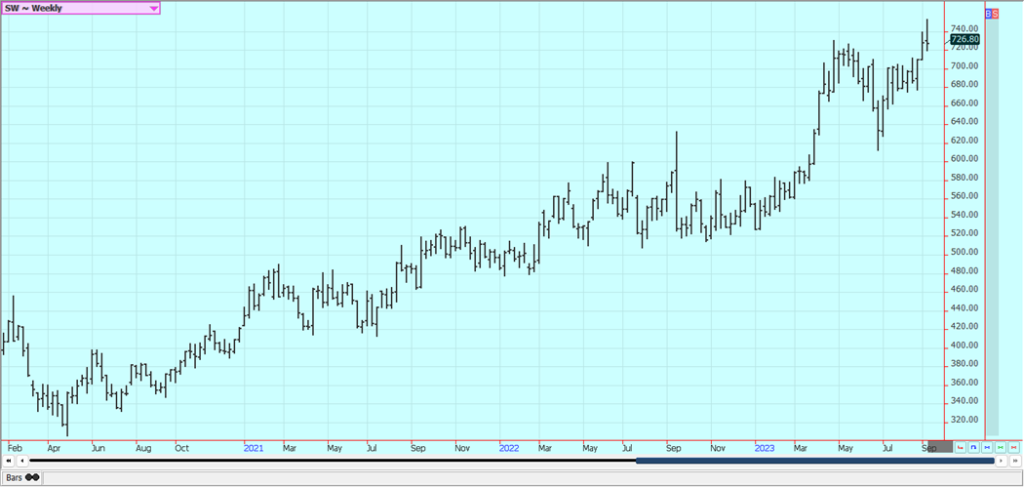
Cocoa: New York and London closed higher last week on reports of diseases in West Africa that are hurting production. The diseases are from too much rain falling at this time. Ideas of tight supplies remain based on more reports of reduced arrivals in Ivory Coast and Ghana continue,
The Talk is that hot and dry conditions reported earlier in Ivory Coast could curtail main crop production, and main crop production ideas are not strong. Midcrop production ideas are lower now with diseases reported in the trees due to too much rain that could also affect the main crop production.
Weekly New York Cocoa Futures
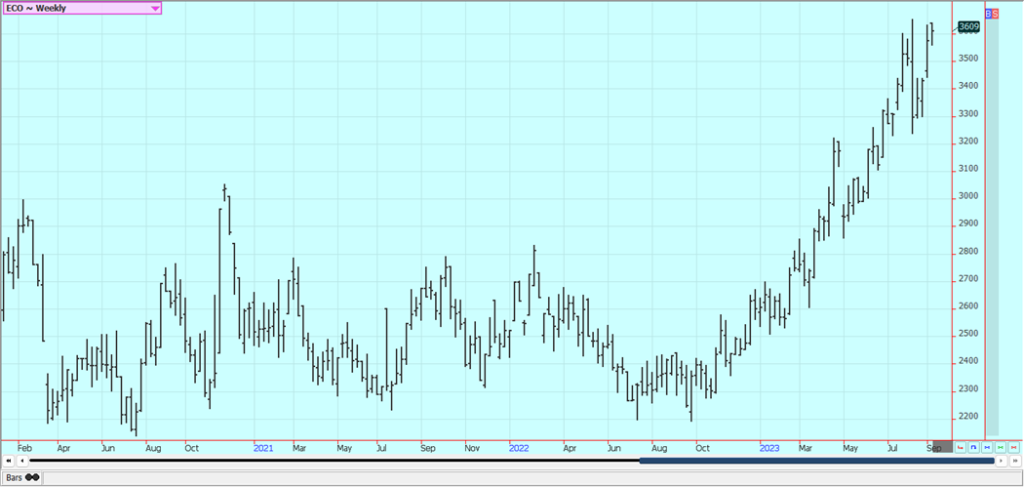
Weekly London Cocoa Futures
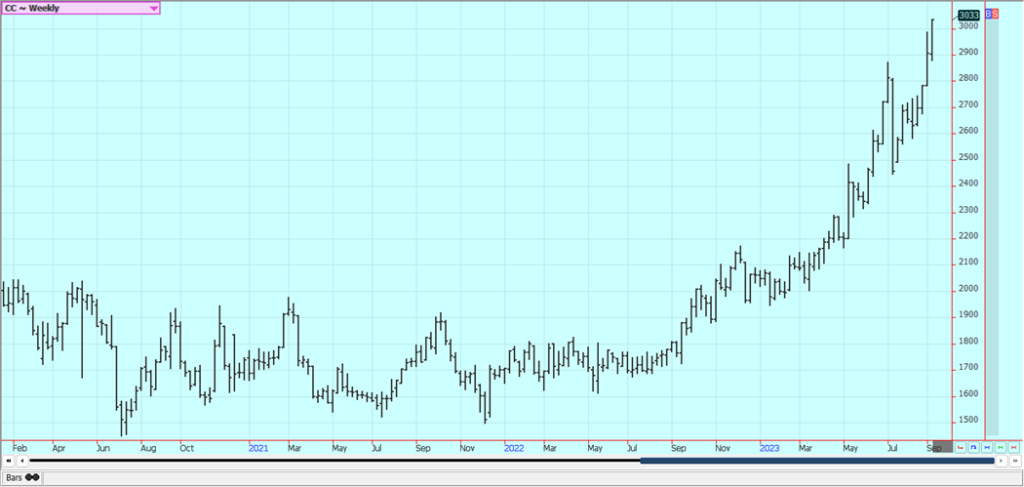
__
(Featured image by NoName_13 via Pixabay)
DISCLAIMER: This article was written by a third party contributor and does not reflect the opinion of Born2Invest, its management, staff or its associates. Please review our disclaimer for more information.
This article may include forward-looking statements. These forward-looking statements generally are identified by the words “believe,” “project,” “estimate,” “become,” “plan,” “will,” and similar expressions. These forward-looking statements involve known and unknown risks as well as uncertainties, including those discussed in the following cautionary statements and elsewhere in this article and on this site. Although the Company may believe that its expectations are based on reasonable assumptions, the actual results that the Company may achieve may differ materially from any forward-looking statements, which reflect the opinions of the management of the Company only as of the date hereof. Additionally, please make sure to read these important disclosures.
Futures and options trading involves substantial risk of loss and may not be suitable for everyone. The valuation of futures and options may fluctuate and as a result, clients may lose more than their original investment. In no event should the content of this website be construed as an express or implied promise, guarantee, or implication by or from The PRICE Futures Group, Inc. that you will profit or that losses can or will be limited whatsoever. Past performance is not indicative of future results. Information provided on this report is intended solely for informative purpose and is obtained from sources believed to be reliable. No guarantee of any kind is implied or possible where projections of future conditions are attempted. The leverage created by trading on margin can work against you as well as for you, and losses can exceed your entire investment. Before opening an account and trading, you should seek advice from your advisors as appropriate to ensure that you understand the risks and can withstand the losses.

-

 Crypto1 week ago
Crypto1 week agoXRP Poised for a Breakout: Why 2026 Could Finally Deliver the Growth 2025 Delayed
-

 Business4 days ago
Business4 days agoPrecious Metals’ Bull Market Continues
-

 Markets2 weeks ago
Markets2 weeks agoPrecious Metals Surge While Major Indexes Hold Strong Amid Holiday Lull
-

 Africa2 days ago
Africa2 days agoOil Dependence and Economic Resilience: Morocco’s Path to Sustainable Growth

























